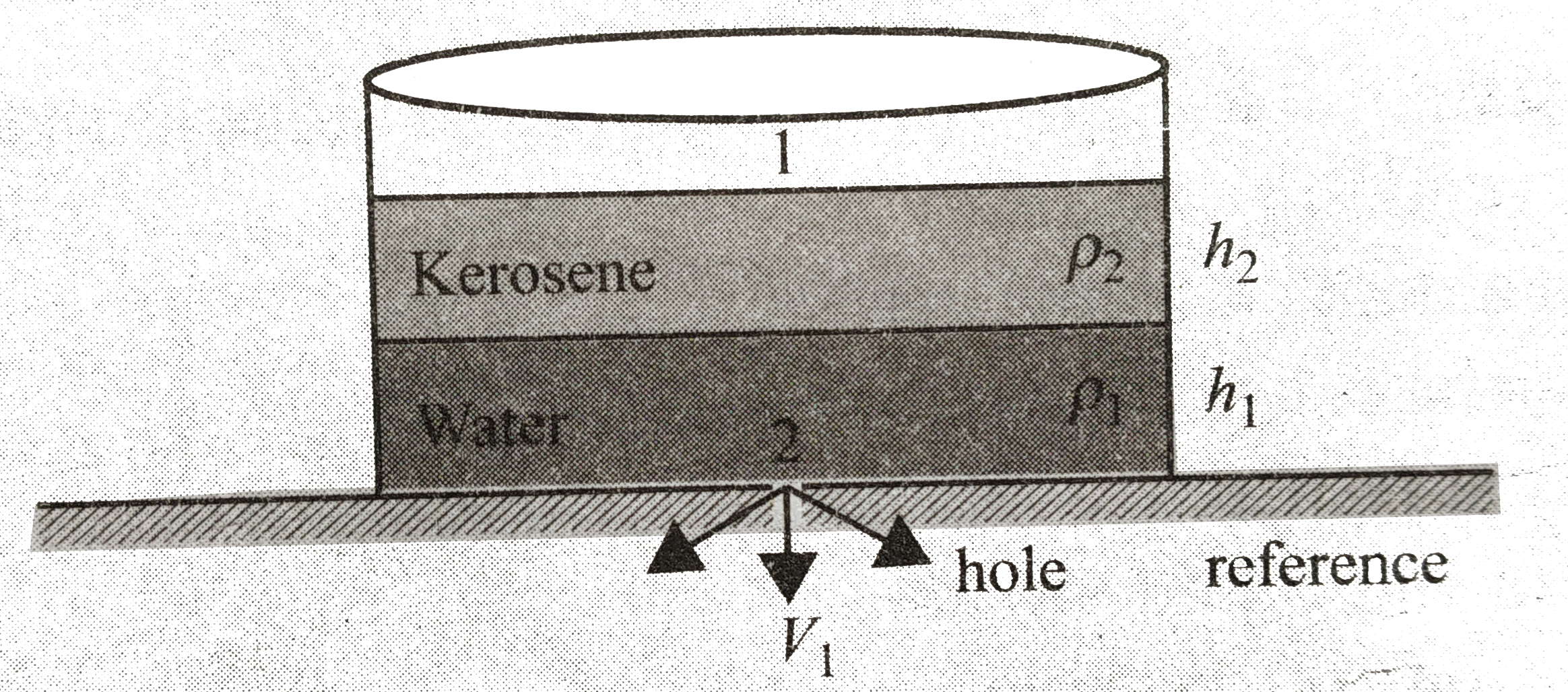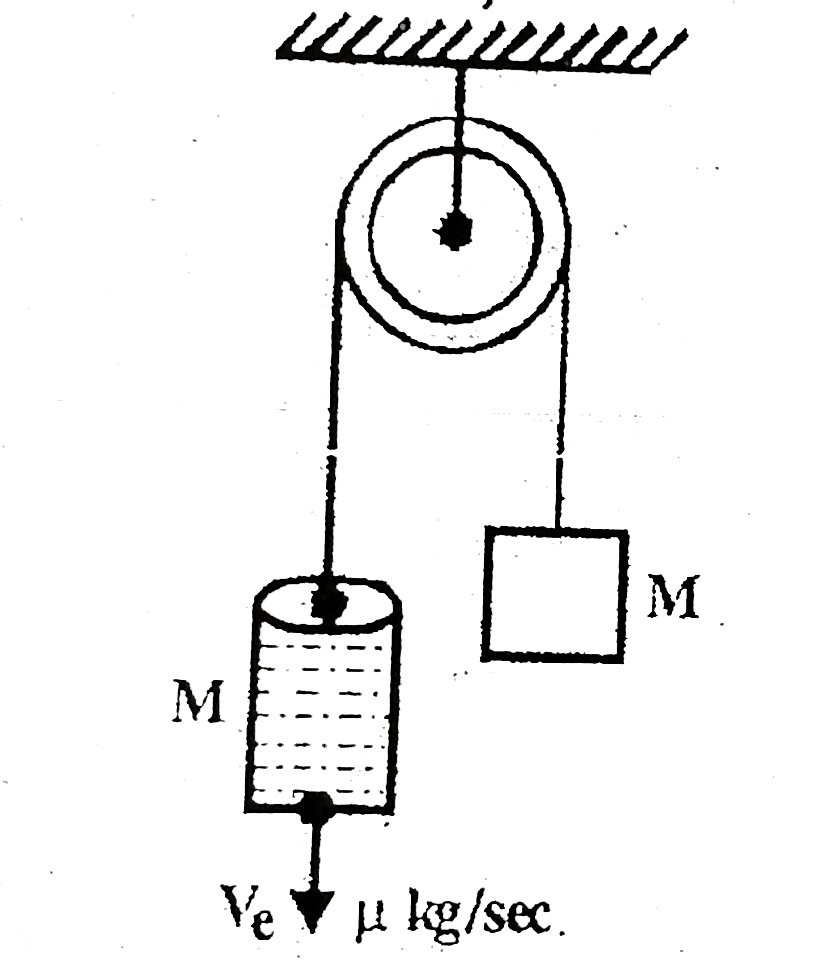Water (p = 1000 kg/m3 ) and kerosene (a = 800kg/m3 ) are filled in two identical cylindrical vessels. Both vessels have small holes at their bottom. The speed of the water and kerosene coming out of their holes are v1 and v2 respectively. Select the correct alternative
v1=v2
v1=0.8v2
0.8v1=v2
v1=√0.8v2
To solve the problem, we will apply Bernoulli's theorem to both vessels containing water and kerosene. The key point is that the speed of fluid flowing out of a hole at the bottom of a vessel depends on the height of the fluid column above the hole, not on the density of the fluid.
1. Understand the Setup:
- We have two identical cylindrical vessels filled with water (density p1=1000kg/m3) and kerosene (density p2=800kg/m3).
- Both vessels have small holes at their bottoms.
2. Apply Bernoulli's Equation:
- According to Bernoulli's theorem, for a fluid flowing from a higher elevation to a lower elevation, the speed of the fluid can be derived from the height of the fluid column.
- The equation can be simplified for our case:
v=√2gh
where v is the speed of the fluid exiting the hole, g is the acceleration due to gravity, and h is the height of the fluid column above the hole.
3. Identify the Heights:
- Let h1 be the height of the water column in the water vessel and h2 be the height of the kerosene column in the kerosene vessel.
- Since both vessels are identical and filled to the same height, we have h1=h2=h.
4. Calculate the Speeds:
- For water, the speed v1 is given by:
v1=√2gh1=√2gh
- For kerosene, the speed v2 is given by:
v2=√2gh2=√2gh
5. Compare the Speeds:
- Since both heights are equal, we have:
v1=v2
6. Conclusion:
- Therefore, the speed of water coming out of the hole v1 is equal to the speed of kerosene coming out of the hole v2.
- The correct answer is:
v1=v2
- We have two identical cylindrical vessels filled with water (density p1=1000kg/m3) and kerosene (density p2=800kg/m3).
- Both vessels have small holes at their bottoms.
- According to Bernoulli's theorem, for a fluid flowing from a higher elevation to a lower elevation, the speed of the fluid can be derived from the height of the fluid column.
- The equation can be simplified for our case:
v=√2gh
where v is the speed of the fluid exiting the hole, g is the acceleration due to gravity, and h is the height of the fluid column above the hole.
- Let h1 be the height of the water column in the water vessel and h2 be the height of the kerosene column in the kerosene vessel.
- Since both vessels are identical and filled to the same height, we have h1=h2=h.
- For water, the speed v1 is given by:
v1=√2gh1=√2gh
- For kerosene, the speed v2 is given by:
v2=√2gh2=√2gh
- Since both heights are equal, we have:
v1=v2
- Therefore, the speed of water coming out of the hole v1 is equal to the speed of kerosene coming out of the hole v2.
- The correct answer is:
v1=v2
Similar Questions
Water and mercury are filled in two cylindrical vessels up to same height. Both vessels have a hole in the wall near the bottom. The velocity of water and mercury coming out of the holes are v1andv2 respectively. Then
View SolutionA wide vessel with a small hole in the bottom is filled with water and kerosene. Find the velocity of water flow if the thickness of water layer is h1=30cm and that of kerosene is h2=20cm brgt

View Solution
Knowledge Check
Two identical photocathodes receive light of frequencies v1andv2. If the velocities of the photoelectrons (of mass m) coming out are respectively v1andv2. then
Av21+v22=2hm(v1−v2)Bv1+v2[=2hm(v1+v2)]1/2Cv21+v22=2hm(v1+v2)Dv1−v2[=2hm(v1+v2)]1/2
Two identical photo-cathodes receive light of frequencies v1 and v2. If the velocities of the photoelectrons (of mass m) coming out are v1 and v2 respectively, then
View SolutionA block of mass M and cylindrical tank which contains water having small hole at bottom, which is closed initially (total mass of cylinder + water is also M), are attached at two ends of an ideal string which passes over an ideal pulley as shown. At t=0 hole is opened such that water starts coming out of the hole with a constant rate μkg/s and constant velocity Ve relative to the cyliender. aSccleration of the block at any time t will be : (Given that string always remains taut.)

View SolutionTwo identical photocathode receive light of frequencies f1 and f2. If the maximum velocities of the photoelectrons (of mass m) coming out are respectively v1 and v2 then:
View SolutionWater is being poured in a vessel at a constant rate αm2/s. There is a small hole of area a at the bottom of the tank. The maximum level of water in the vessel is proportional to
View SolutionWater level is maintained ina cylindrical vessel up to a fixed height H. The vessel is kept on a horizontal plane. At what height above the bottom should a hole be made in the vessel so that the water stream coming out of the hole strikes the horizontal plane at the greatest distance from the vessel.

View SolutionThere is a small hole at the bottom of tank filled with water. If total pressure at the bottom is 3atm(1atm=105Nm−2), then find the velocity of water flowing from hole.
View SolutionThere is a small hole at the bottom of tank filled with water. If total pressure at the bottom is 3atm(1atm=105Nm−2), then find the velocity of water flowing from hole.
View Solution
